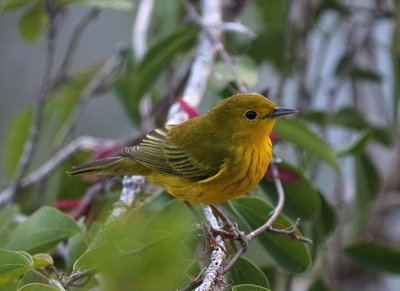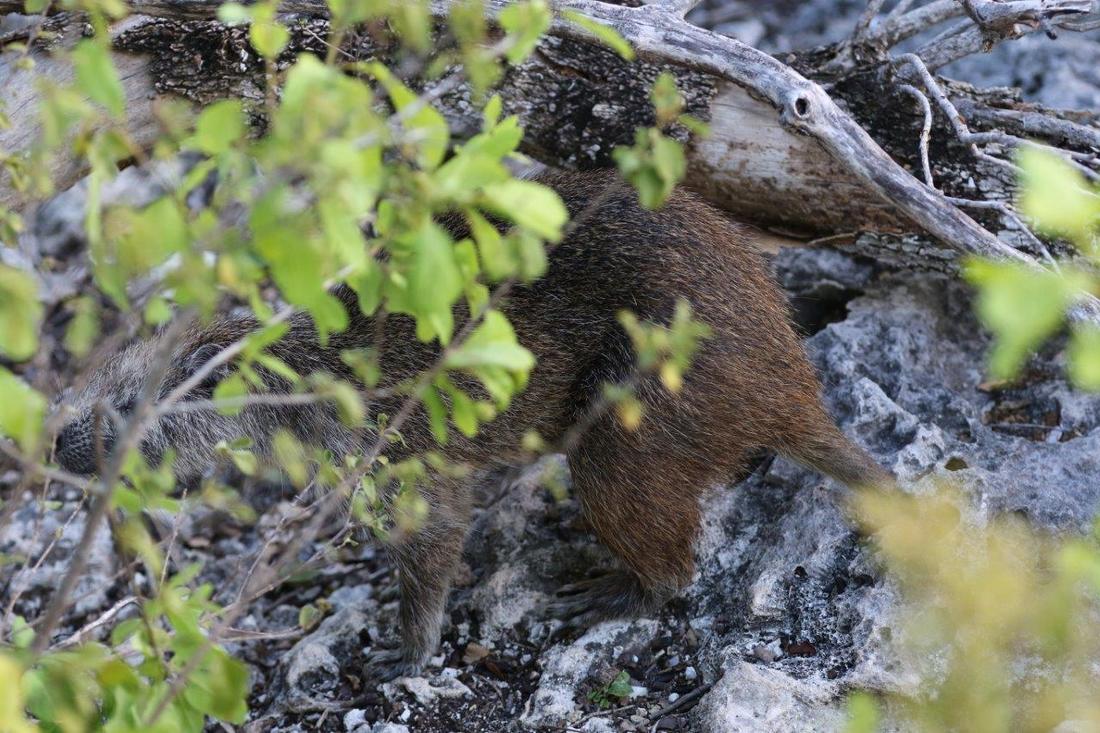They are hunted for food in Cuba, where they are often cooked in a large pot with wild nuts and honey. At the Guantanamo Bay Naval Base however, there is a good population due to an abundant food source and the lack of natural predators. Desmarest's Jutías are referred to by those stationed there as banana rats not for their dietary preference but because their droppings look like small versions of the fruit.
|
Being a security guard at the hotels must be a pretty boring job at the best of times. There's a lot of standing around with no-one to talk to so we usually stop and have a chat and Lynn practices her Spanish on them, and they often welcome the chance to practice their English. When Lynn was returning from an early morning swim yesterday she chatted to one of the guards who told her that he sometimes saw Jutías amongst the jumble of rocks overlooking the lagoon. We later went to check it out and although we didn't see any we did find evidence that they were there. There was a pile of droppings by the path. Jutías, otherwise called tree rats, are large rodents and confined to the Caribbean. Twenty-one species are known but many of these are are already extinct including some from Cuba where ten species were once found but most of which are now threatened. Only Desmarest's Jutía Capromys pilorides and the Prehensile-tailed Jutía Mysateles prehensilis remain common and widespread. They are largely nocturnal and are vegetarian, their diet consisting of leaves, the bark of trees, fruits, and even roots and tubers. They are hunted for food in Cuba, where they are often cooked in a large pot with wild nuts and honey. At the Guantanamo Bay Naval Base however, there is a good population due to an abundant food source and the lack of natural predators. Desmarest's Jutías are referred to by those stationed there as banana rats not for their dietary preference but because their droppings look like small versions of the fruit. So this morning I went to the spot at first light while Lynn was having a swim to try and see and photograph one. There were a few warblers around as I crept into position and I spent a while photographing them. The light was still poor so I had to change the settings to ISO1000 but I was quite pleased with the results of this Yellow Warbler considering. I couldn't work out why they had pale patches on the forehead until I saw one taking nectar from a Passiflora cuprea flower (thank you Eddy for the id) and then it became clear that these flowers have evolved to be pollinated by birds and the pale patch on the forehead was pollen rubbed from the stamens that are held high above the flower itself. I then saw an adult Prairie Warbler doing exactly the same thing. I heard a scrabbling on the rocks below me and looked down to see a Jutía but I'm sure it was aware of my presence and it moved out of view so I in turn moved back into the bushes on the off-chance that it wanted to come up the path past me. And in a few minutes it did just that, pausing briefly behind a bush preventing me from getting a clear shot but it was a Jutía nonetheless - very exciting, and just a few feet away from me. I'm pretty sure this is Desmarest's Jutía Capromys pilorides but I wouldn't swear to it. And there was also an Anole that I didn't recognise immediately, running around on the rocks below me. I now know that it is Anolis lucius. What a brilliant hour of wildlife-watching - and all before breakfast. The rest of the day was spent in or around the hotel garden and in a small clearing nearby where we spent time sitting in the shade watching the butterflies coming to a flowering bush. We saw the Mexican Sailor Dynamine postverta again and a De Villiers Swallowtail Battus devilliers along with Caribbean Banner Lucinia sida and a few skippers and several whites and sulphurs. While photographing a Florida Duskywing Ephyriades brunnea larva that was getting ready to pupate I heard a loud squawking above me and found that I was being watched by a Yellow-crowned Night Heron. And the only decent butterfly photo of the day was a Mallow Scrub-Hairstreak Strymon istapa down near the beach.
0 Comments
Leave a Reply. |
Welcome to our Blog
Here we will post interesting news about what we and others have seen in Cuba. Archives
July 2024
Categories |












 RSS Feed
RSS Feed